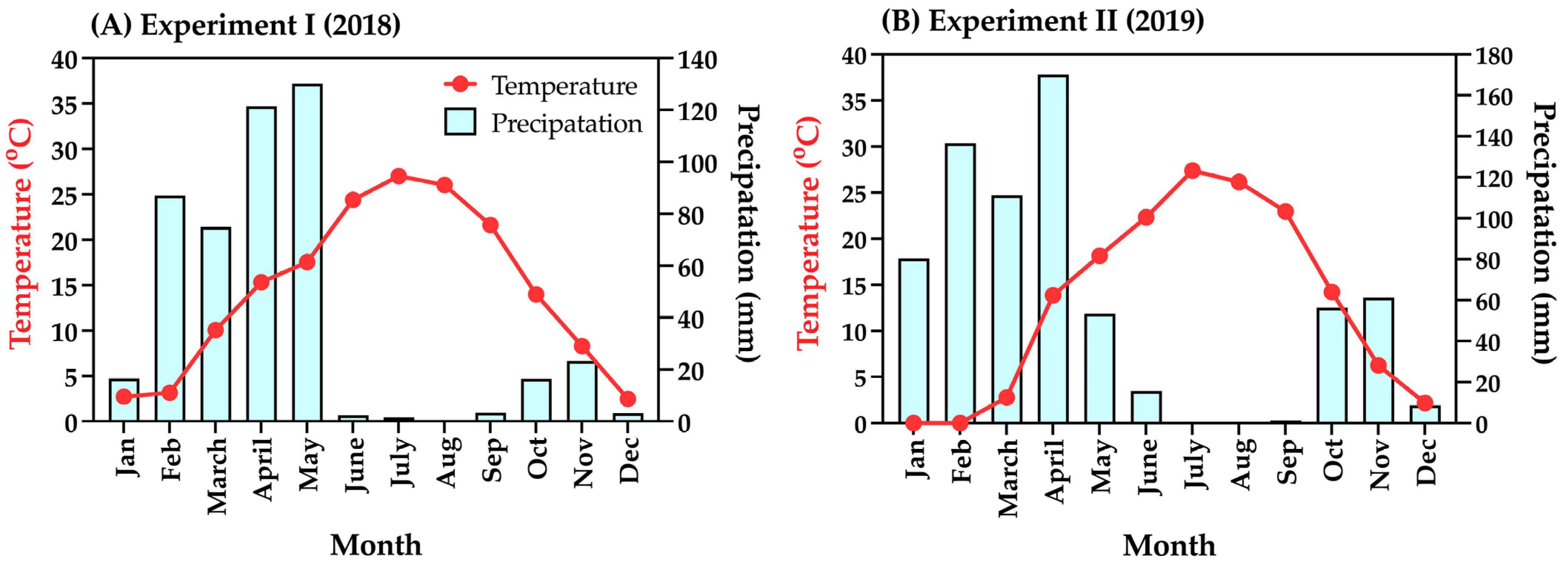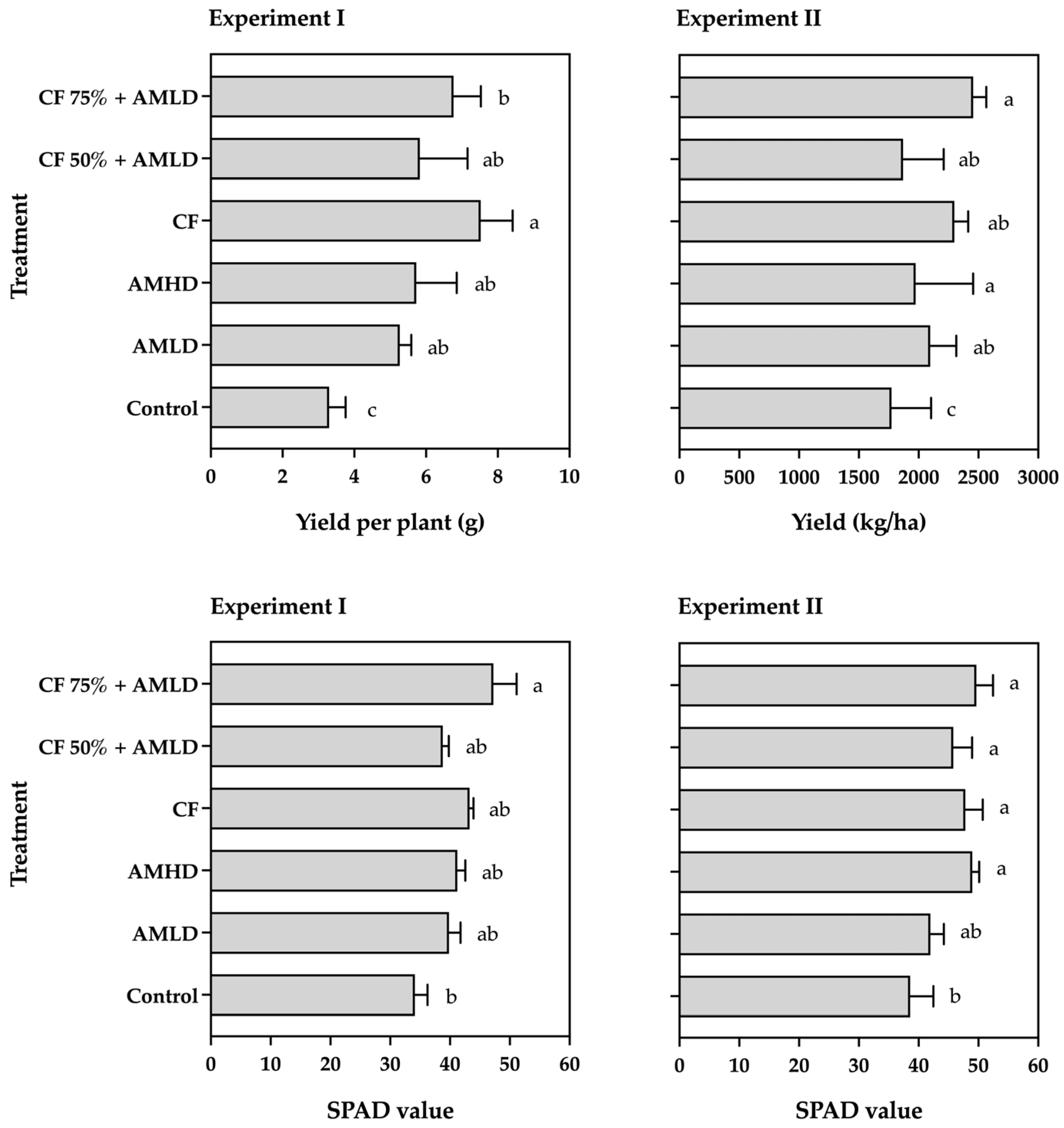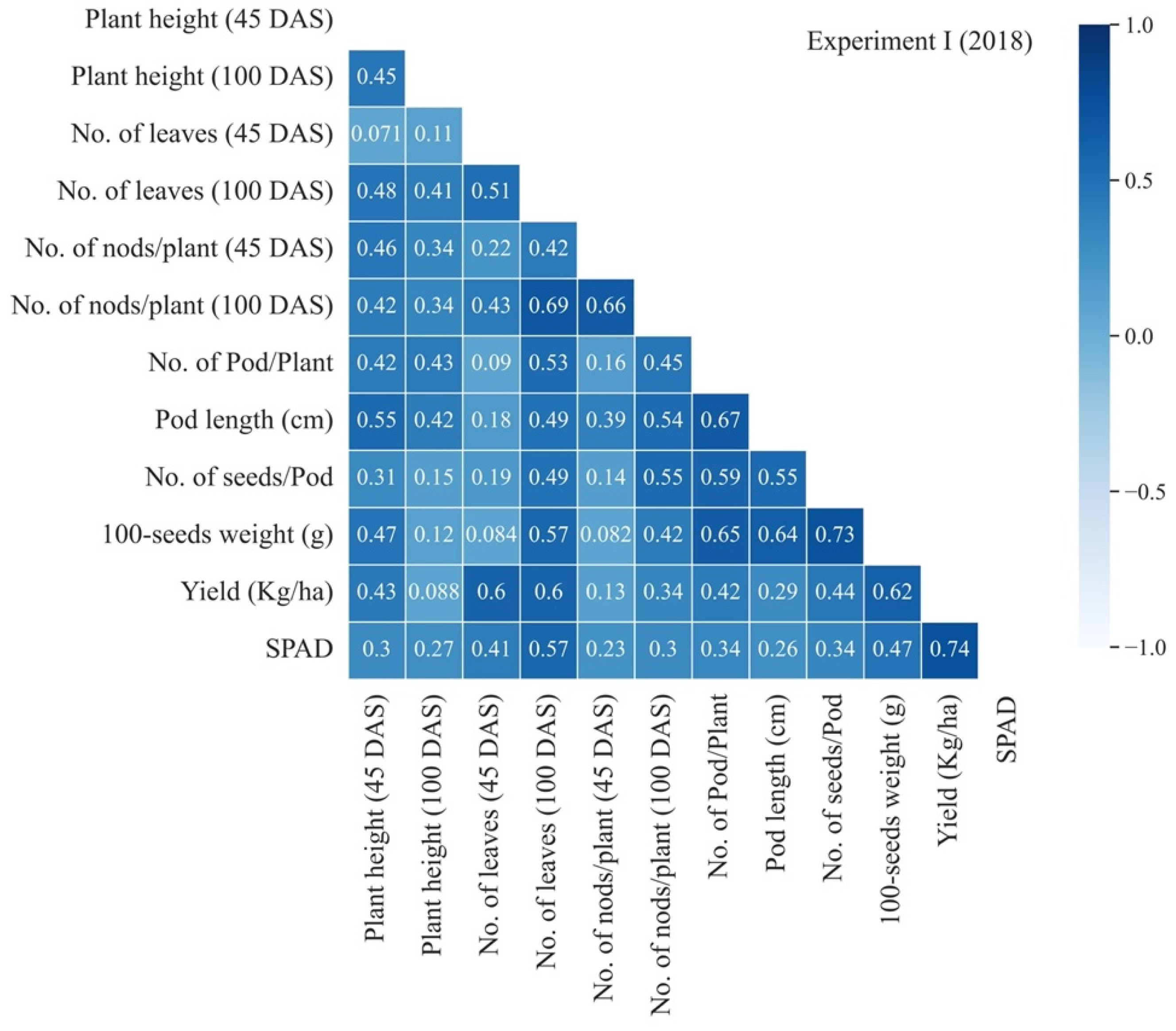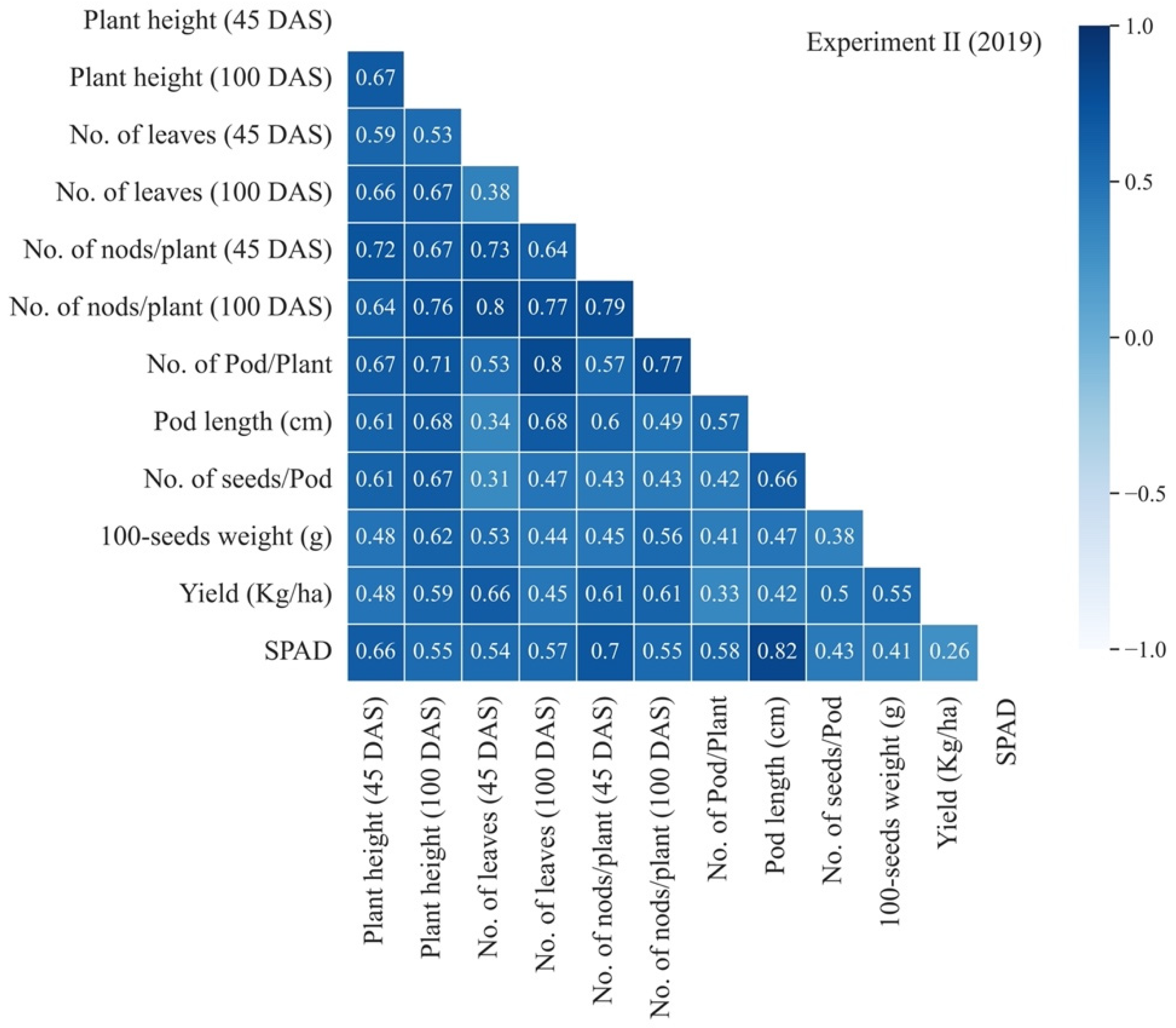Optimizing Soybean Crop Performance through the Integrated Application of Organic and Chemical Fertilizers: A Study on Alkaline Soil in Afghanistan
Abstract
:1. Introduction
2. Materials and Methods
2.1. Experimental Site and Treatments
2.2. Plant Measurements
2.3. Statistical Analysis
3. Results
3.1. Effects of Integrated Animal Manure and Chemical Fertilizer on Soybean Growth Attributes and Yield Components
3.2. Impacts of Integrated Animal Manure and Chemical Fertilizer on Yield and SPAD Value of Soybean
3.3. Correlation of Vegetative Growth with Yield Attributes
4. Discussion
5. Conclusions
Author Contributions
Funding
Data Availability Statement
Conflicts of Interest
References
- Pan, R.; Lin, J.; Cai, J.; Zhang, L.; Liu, J.; Wen, X.; Chen, X.; Zhang, X. A Two-Stage Feature Aggregation Network for Multi-Category Soybean Leaf Disease Identification. J. King Saud Univ. Comput. Inf. Sci. 2023, 35, 101669. [Google Scholar] [CrossRef]
- Li, Y.; Zeng, H.; Zhang, M.; Wu, B.; Zhao, Y.; Yao, X.; Cheng, T.; Qin, X.; Wu, F. A County-Level Soybean Yield Prediction Framework Coupled with XGBoost and Multidimensional Feature Engineering. Int. J. Appl. Earth Obs. Geoinf. 2023, 118, 103269. [Google Scholar] [CrossRef]
- Thapa, S.; Bhandari, A.; Ghimire, R.; Xue, Q.; Kidwaro, F.; Ghatrehsamani, S.; Maharjan, B.; Goodwin, M. Managing Micronutrients for Improving Soil Fertility, Health, and Soybean Yield. Sustainability 2021, 13, 11766. [Google Scholar] [CrossRef]
- Islam, M.S.; Ayman, E.S.; Murat, E. Soybean and Sustainable Agriculture for Food Security. In Soybean—Recent Advances in Research and Applications; IntechOpen: London, UK, 2022. [Google Scholar]
- Wang, H.; Guohui, S.; Zizhong, S.; Xiangdong, H. Effects of Climate and Price on Soybean Production: Empirical Analysis Based on Panel Data of 116 Prefecture-Level Chinese Cities. PLoS ONE 2023, 18, e0273887. [Google Scholar] [CrossRef] [PubMed]
- USB. Global Food Security Challenge Accepted and Met by U.S. Soy|United Soybean Board. Available online: https://www.unitedsoybean.org/hopper/global-food-security-challenge-accepted-and-met-by-us-soy/ (accessed on 5 January 2024).
- Role, H.E.; Soybeanfighting, O.F.; Hunger, W. FAO Commodities and Trade Division, Basic Foodstuffs Service 1, 2. In Plant Production; FAO: Rome, Italy, 2004; pp. 1–32. [Google Scholar]
- Mohammad Sohidul, I.; Imam, M.; Rafiqul, I.; Kamrul, H.; Golam, H.; Moaz, H.; Hirofumi, S.; Akihiro, U.; Liyun, L.; Misbah, N.; et al. Soybean and Sustainable Agriculture for Food Security; Intech Open: London, UK, 2022. [Google Scholar]
- Telles, T.S.; Nogueira, M.A.; Hungria, M. Economic Value of Biological Nitrogen Fixation in Soybean Crops in Brazil. Environ. Technol. Innov. 2023, 31, 103158. [Google Scholar] [CrossRef]
- Nget, R.; Aguilar, E.A.; Cruz, P.C.S.; Reaño, C.E.; Sanchez, P.B.; Reyes, M.R.; Prasad, P.V.V. Responses of Soybean Genotypes to Different Nitrogen and Phosphorus Sources: Impacts on Yield Components, Seed Yield, and Seed Protein. Plants 2022, 11, 298. [Google Scholar] [CrossRef] [PubMed]
- Gao, S.; Wang, S.; Hu, Y.; Chen, S.; Guo, J.; Shi, L. Comparative Differences in Photosynthetic Characteristics, Ion Balance, and Nitrogen Metabolism between Young and Old Wild Soybean Leaves under Nitrogen Deficiency. Plant Stress 2022, 4, 100064. [Google Scholar] [CrossRef]
- Zhao, T.; He, A.; Khan, M.N.; Yin, Q.; Song, S.; Nie, L. Coupling of Reduced Inorganic Fertilizer with Plant-Based Organic Fertilizer as a Promising Fertilizer Management for Colored Rice in Tropical Regions. J. Integr. Agric. 2023, 23, 93–107. [Google Scholar] [CrossRef]
- Zhang, M.; Tian, Y.; Zhao, M.; Yin, B.; Zhu, Z. The Assessment of Nitrate Leaching in a Rice–Wheat Rotation System Using an Improved Agronomic Practice Aimed to Increase Rice Crop Yields. Agric. Ecosyst. Environ. 2017, 241, 100–109. [Google Scholar] [CrossRef]
- Chen, X.; Wo, F.; Chen, C.; Fang, K. Seasonal Changes in the Concentrations of Nitrogen and Phosphorus in Farmland Drainage and Groundwater of the Taihu Lake Region of China. Environ. Monit. Assess. 2010, 169, 159–168. [Google Scholar] [CrossRef]
- Ju, X.T.; Xing, G.X.; Chen, X.P.; Zhang, S.L.; Zhang, L.J.; Liu, X.J.; Cui, Z.L.; Yin, B.; Christie, P.; Zhu, Z.L.; et al. Reducing Environmental Risk by Improving N Management in Intensive Chinese Agricultural Systems. Proc. Natl. Acad. Sci. USA 2009, 106, 3041–3046. [Google Scholar] [CrossRef] [PubMed]
- Fu, C.; Ma, W.; Qiang, B.; Jin, X.; Zhang, Y.; Wang, M. Effect of Chemical Fertilizer with Compound Microbial Fertilizer on Soil Physical Properties and Soybean Yield. Agronomy 2023, 13, 2488. [Google Scholar] [CrossRef]
- Li, Y.; Chen, P.; Fu, Z.; Luo, K.; Lin, P.; Gao, C.; Liu, S.; Pu, T.; Yong, T.; Yang, W. Maize–Soybean Relay Cropping Increases Soybean Yield Synergistically by Extending the Post-Anthesis Leaf Stay-Green Period and Accelerating Grain Filling. Crop J. 2023, 11, 1921–1930. [Google Scholar] [CrossRef]
- Raza, M.A.; Yasin, H.S.; Gul, H.; Qin, R.; Mohi Ud Din, A.; Khalid, M.H.; Bin Hussain, S.; Gitari, H.; Saeed, A.; Wang, J.; et al. Maize/Soybean Strip Intercropping Produces Higher Crop Yields and Saves Water under Semi-Arid Conditions. Front. Plant Sci. 2022, 13, 6720. [Google Scholar] [CrossRef] [PubMed]
- Hua, W.; Luo, P.; An, N.; Cai, F.; Zhang, S.; Chen, K.; Yang, J.; Han, X. Manure Application Increased Crop Yields by Promoting Nitrogen Use Efficiency in the Soils of 40-Year Soybean-Maize Rotation. Sci. Rep. 2020, 10, 14882. [Google Scholar] [CrossRef] [PubMed]
- Raza, M.A.; Din, A.M.U.; Zhiqi, W.; Gul, H.; Ur Rehman, S.; Bukhari, B.; Haider, I.; Rahman, M.H.U.; Liang, X.; Luo, S.; et al. Spatial Differences Influence Nitrogen Uptake, Grain Yield, and Land-Use Advantage of Wheat/Soybean Relay Intercropping Systems. Sci. Rep. 2023, 13, 16916. [Google Scholar] [CrossRef] [PubMed]
- Hati, K.M.; Mandal, K.G.; Misra, A.K.; Ghosh, P.K.; Bandyopadhyay, K.K. Effect of Inorganic Fertilizer and Farmyard Manure on Soil Physical Properties, Root Distribution, and Water-Use Efficiency of Soybean in Vertisols of Central India. Bioresour. Technol. 2006, 97, 2182–2188. [Google Scholar] [CrossRef]
- Carlos, F.S.; Schaffer, N.; Mariot, R.F.; Fernandes, R.S.; Boechat, C.L.; Roesch, L.F.W.; Camargo, F.A. Soybean Crop Incorporation in Irrigated Rice Cultivation Improves Nitrogen Availability, Soil Microbial Diversity and Activity, and Growth of Ryegrass. Appl. Soil Ecol. 2022, 170, 104313. [Google Scholar] [CrossRef]
- Habibi, S.; Ayubi, A.G.; Ohkama-Ohtsu, N.; Sekimoto, H.; Yokoyama, T. Genetic Characterization of Soybean Rhizobia Isolated from Different Ecological Zones in North-Eastern Afghanistan. Microbes Environ. 2017, 32, 71–79. [Google Scholar] [CrossRef]
- FAO. Project Areas; FAO: Rome, Italy, 2022; Available online: https://www.fao.org/documents/card/en/c/cb8429en (accessed on 22 January 2024).
- NEI. Soybean Faraming—Nutrition & Education International. Nutrition & Education International. Available online: https://www.neifoundation.org/soybean-farming (accessed on 22 January 2024).
- CHA. Coordination of Humanitarian Assistance (CHA). Available online: https://www.devex.com/organizations/coordination-of-humanitarian-assistance-cha-29113 (accessed on 22 January 2024).
- FAO. Strengthening Soya Production and Food System in Afghanistan. In FAO Publications Catalogue 2023; FAO: Rome, Italy, 2023. [Google Scholar] [CrossRef]
- The World Bank. Food Security|Rising Food Insecurity in 2023. Available online: https://www.worldbank.org/en/topic/agriculture/brief/food-security-update (accessed on 22 January 2024).
- Asodina, F.A.; Adams, F.; Nimoh, F.; Asante, B.O.; Mensah, A. Performance of Smallholder Soybean Farmers in Ghana; Evidence from Upper West Region of Ghana. J. Agric. Food Res. 2021, 4, 100120. [Google Scholar] [CrossRef]
- Savage, M.; Dougherty, B.; Hamza, M.; Butterfield, R.; Bharwani, S. Socio-Economic Impacts of Climate Change in Afghanistan; Stockholm Environment Institute: Oxford, UK, 2023. [Google Scholar]
- Ahmadi, J. Afghanistan Geography: Mountain Regions and Region Specific Soil Types. Int. J. Multidiscip. Res. Growth Eval. 2021, 2, 326–328. [Google Scholar]
- Hashimi, R.; Matsuura, E.; Komatsuzaki, M. Effects of Cultivating Rice and Wheat with and without Organic Fertilizer Application on Greenhouse Gas Emissions and Soil Quality in Khost, Afghanistan. Sustainability 2020, 12, 6508. [Google Scholar] [CrossRef]
- FAO. FAO/WFP Crop and Food Supply Assessment Mission to Afghanistan; FAO: Rome, Italy, 1997; Available online: https://www.fao.org/3/Y7376e/Y7376e00.htm (accessed on 22 January 2024).
- Zaryab, A.; Nassery, H.R.; Knoeller, K.; Alijani, F.; Minet, E. Determining Nitrate Pollution Sources in the Kabul Plain Aquifer (Afghanistan) Using Stable Isotopes and Bayesian Stable Isotope Mixing Model. Sci. Total Environ. 2022, 823, 153749. [Google Scholar] [CrossRef] [PubMed]
- Weather Meta—Meteoblue. Available online: https://www.meteoblue.com/en/weather/week/meta_italy_3173524 (accessed on 3 April 2023).
- Gao, J.; Luo, J.; Lindsey, S.; Shi, Y.; Wei, Z.; Wang, L.; Zhang, L. Effects of Soil Properties on Urea-N Transformation and Efficacy of Nitrification Inhibitor 3, 4-Dimethypyrazole Phosphate (DMPP). Soil Sci. Plant Nutr. 2022, 68, 228–237. [Google Scholar] [CrossRef]
- Yagoub, S.O.; Ahmed, W.M.A.; Mariod, A.A. Effect of Urea, NPK and Compost on Growth and Yield of Soybean (Glycine Max L.), in Semi-Arid Region of Sudan. ISRN Agron. 2012, 2012, 1–6. [Google Scholar] [CrossRef]
- Iqbal, M.A.; Hussain, I.; Hamid, A.; Ahmad, B.; Ishaq, S.; Sabagh, A.; El Barutçular, C.; Khan, R.D.; Imran, M. Soybean Herbage Yield, Nutritional Value and Profitability under Integrated Manures Management. An. Acad. Bras. Cienc. 2021, 93, e20181384. [Google Scholar] [CrossRef] [PubMed]
- Devi, K.N.; Singh, T.B.; Athokpam, H.S.; Singh, N.B.; Shamurailatpam, D. Influence of Inorganic, Biological and Organic Manures on Nodulation and Yield of Soybean (Glycine Max Merril L.) and Soil Properties. Aust. J. Crop Sci. 2013, 7, 1407–1415. [Google Scholar]
- Amarendra, S. Effect of Organic and Inorganic Fertilizers on Onion Crop. J. Plant Prod. 2012, 25, 5813–5830. [Google Scholar] [CrossRef]
- Ratih, S.; Zainal, A. Effect of Organic and Chemical Fertilizers on the Growth and Flowering of Freesia Plant. Int. J. Agric. Stat. Sci. 2021, 17, 1059–1062. [Google Scholar]
- Gai, Z.; Zhang, J.; Li, C. Effects of Starter Nitrogen Fertilizer on Soybean Root Activity, Leaf Photosynthesis and Grain Yield. PLoS ONE 2017, 12, e0174841. [Google Scholar] [CrossRef]
- Liu, X.; Rezaei Rashti, M.; Dougall, A.; Esfandbod, M.; Van Zwieten, L.; Chen, C. Subsoil Application of Compost Improved Sugarcane Yield through Enhanced Supply and Cycling of Soil Labile Organic Carbon and Nitrogen in an Acidic Soil at Tropical Australia. Soil Tillage Res. 2018, 180, 73–81. [Google Scholar] [CrossRef]
- Cui, X.; Guo, L.; Li, C.; Liu, M.; Wu, G.; Jiang, G. The Total Biomass Nitrogen Reservoir and Its Potential of Replacing Chemical Fertilizers in China. Renew. Sustain. Energy Rev. 2021, 135, 110215. [Google Scholar] [CrossRef]
- Zhang, Y.-J.; Gao, W.; Luan, H.-A.; Tang, J.-W.; Li, R.-N.; Li, M.-Y.; Zhang, H.-Z.; Huang, S.-W. Effects of a Decade of Organic Fertilizer Substitution on Vegetable Yield and Soil Phosphorus Pools, Phosphatase Activities, and the Microbial Community in a Greenhouse Vegetable Production System. J. Integr. Agric. 2022, 21, 2119–2133. [Google Scholar] [CrossRef]
- Hernández, T.; Chocano, C.; Moreno, J.L.; García, C. Towards a More Sustainable Fertilization: Combined Use of Compost and Inorganic Fertilization for Tomato Cultivation. Agric. Ecosyst. Environ. 2014, 196, 178–184. [Google Scholar] [CrossRef]
- Wang, Y.; Zhu, Y.; Zhang, S.; Wang, Y. What Could Promote Farmers to Replace Chemical Fertilizers with Organic Fertilizers? J. Clean. Prod. 2018, 199, 882–890. [Google Scholar] [CrossRef]
- Onyenali, T.; Olowe, V.; Fabunmi, T.; Soretire, A. Organic Fertilizers Improve the Growth, Seed Quality and Yield of Newly Released Soybean (Glycine Max (L.) Merrill) Varieties in the Tropics. Org. Agric. 2020, 10, 155–170. [Google Scholar] [CrossRef]
- Manning, D.A.C. Mineral Sources of Potassium for Plant Nutrition. A Review. Agron. Sustain. Dev. 2012, 30, 281–294. [Google Scholar] [CrossRef]




| Treatment | Source | Description |
|---|---|---|
| Control | No fertilizer | - |
| Animal manure light dose (AMLD) | Animal manure | 5 t ha−1 of well-decomposed animal manure was utilized. |
| Animal manure heavy dose (AMHD) | Animal manure | 10 t ha−1 of well-decomposed animal manure was utilized. |
| Chemical fertilizer (CF) | Urea (46% nitrogen) | 110 kg Urea/ha. |
| CF 50% + AMLD | Urea + animal manure | 55 kg Urea/ha + 5 t ha−1 animal manure. |
| CF 75% + AMLD | Urea + animal manure | 82.5 kg Urea/ha + t ha−1 animal manure. |
| Soil Characteristic | Value |
|---|---|
| pH | 8.10 |
| EC (dS/cm) | 17.0 |
| OM (%) | 0.6 |
| N (ppm) | 8.3 |
| P (ppm) | 9.3 |
| K (ppm) | 68.2 |
| CaCO3 (%) | 14.1 |
| S (ppm) | 6.4 |
| Mg (ppm) | 10.1 |
| Soil texture | Silty loam |
| Treatment | Plant Height (cm) | Number of Leaves per Plant | Number of Nodes per Plant | |||||||||
|---|---|---|---|---|---|---|---|---|---|---|---|---|
| 45 DAS | 100 DAS | 45 DAS | 100 DAS | 45 DAS | 100 DAS | |||||||
| Experiment I | Experiment II | Experiment I | Experiment II | Experiment I | Experiment II | Experiment I | Experiment II | Experiment I | Experiment II | Experiment I | Experiment II | |
| Control | 21.3 ± 2.4 b | 32.2 ± 2.9 b | 34.7 ± 5.4 a | 57.9 ± 4.2 b | 23.7 ± 6.8 c | 34.4 ± 7.7 b | 63.5 ± 21.1 b | 147.8 ± 16.3 b | 10.2 ± 3.4 ab | 12.3 ± 2.3 c | 23.2 ± 2.3 c | 38.3 ± 3.4 d |
| AMLD | 22.1 ± 1.1 ab | 36.6 ± 2.2 ab | 36.5 ± 3.3 a | 71.2 ± 6.3 ab | 27.6 ± 6.1 b | 41.3 ± 5.3 ab | 71.7 ± 11.2 ab | 187.0 ± 7.8 ab | 13.2 ± 5.3 ab | 18.3 ± 3.1 abc | 26.7 ± 4.3 abc | 53.6 ± 4.2 ab |
| AMHD | 22.4 ± 1.9 ab | 36.8 ± 2.0 ab | 36.5 ± 7.8 a | 72.9 ± 4.6 ab | 33.7 ± 15.0 b | 41.5 ± 6.1 ab | 81.0 ± 7.8 ab | 179.7 ± 10.2 ab | 12.5 ± 4.8 a | 16.6 ± 1.7 bc | 26.2 ± 1.2 bc | 49.3 ± 5.2 bc |
| CF | 23.5 ± 2.9 ab | 39.8 ± 1.3 a | 39.0 ± 11.2 a | 78.9 ± 7.1 a | 46.5 ± 6.2 a | 52.041.5 ± 4.2 a | 93.0 ± 6.9 a | 194.7 ± 9.8 a | 16.6 ± 2.1 a | 22.0 ± 5.4 ab | 35.0 ± 3.2 a | 59.349.0 ± 6.1 a |
| CF 50% + AMLD | 23.0 ± 1.2 ab | 36.8 ± 1.3 ab | 35.7 ± 9.9 a | 65.7 ± 5.1 ab | 34.7 ± 5.1 b | 37.8 ± 7.2 ab | 79.7 ± 10.0 ab | 169.2 ± 12.4 ab | 9.7 ± 1.2 b | 14.3 ± 2.1 c | 25.7 ± 1.9 c | 41.0 ± 2.8 cd |
| CF 75% + AMLD | 23.7 ± 2.3 a | 40.5 ± 1.4 a | 38.7 ± 8.1 a | 79.6 ± 8.5 a | 38.0 ± 12.2 b | 52.7 ± 3.4 a | 91.581.0 ± 6.1 a | 190.3 ± 11.1 ab | 12.7 ± 2.3 ab | 24.3 ± 3.6 a | 33.7 ± 2.6 ab | 57.3 ± 2.7 ab |
| p-value | * | * | ns | * | *** | * | ** | * | * | *** | *** | *** |
| Treatment | Number of Pods per Plant | Pod Length (cm) | Number of Seeds per Pod | 100-Seed Weight (g) | ||||
|---|---|---|---|---|---|---|---|---|
| Experiment I | Experiment II | Experiment I | Experiment II | Experiment I | Experiment II | Experiment I | Experiment II | |
| Control | 20.6 ± 4.3 b | 58.8 ± 5.7 b | 2.7 ± 0.9 b | 2.8 ± 0.2 c | 2.3 ± 0.3 b | 3.9 ± 0.1 a | 3.4 ± 0.3 c | 8.2 ± 1.4 a |
| AMLD | 25.3 ± 3.6 ab | 76.4 ± 8.6 ab | 3.3 ± 0.4 ab | 3.4 ± 0.4 bc | 2.5 ± 0.0 ab | 3.9 ± 0.1 a | 4.8 ± 0.1 b | 9.3 ± 1.1 a |
| AMHD | 27.5 ± 5.0 ab | 77.2 ± 6.9 ab | 3.4 ± 0.8 ab | 4.2 ± 0.6 ab | 2.7 ± 0.7 ab | 4.1 ± 0.0 a | 5.3 ± 0.5 ab | 9.3 ± 0.6 a |
| CF | 33.7 ± 6.2 a | 87.1 ± 9.5 ab | 4.0 ± 1.0 ab | 4.5 ± 0.3 ab | 3.0 ± 0.8 a | 4.1 ± 0.2 a | 6.3 ± 0.6 a | 9.5 ± 0.3 a |
| CF 50% + AMLD | 27.5 ± 3.5 ab | 67.6 ± 8.9 ab | 3.6 ± 1.1 ab | 4.3 ± 0.7 ab | 2.7 ± 0.3 ab | 4.0 ± 0.1 a | 5.6 ± 0.3 ab | 9.5 ± 0.5 a |
| CF 75% + AMLD | 29.0 ± 5.5 ab | 89.9 ± 4.7 a | 4.1 ± 0.6 a | 4.7 ± 0.9 a | 2.8 ± 0.1 ab | 4.3 ± 0.3 a | 6.0 ± 0.8 ab | 11.8 ± 1.1 a |
| p-value | ** | * | * | *** | * | ns | *** | ns |
Disclaimer/Publisher’s Note: The statements, opinions and data contained in all publications are solely those of the individual author(s) and contributor(s) and not of MDPI and/or the editor(s). MDPI and/or the editor(s) disclaim responsibility for any injury to people or property resulting from any ideas, methods, instructions or products referred to in the content. |
© 2024 by the authors. Licensee MDPI, Basel, Switzerland. This article is an open access article distributed under the terms and conditions of the Creative Commons Attribution (CC BY) license (https://creativecommons.org/licenses/by/4.0/).
Share and Cite
Turabi, A.B.; Habibi, S.; Kakar, K.; Aryan, S.; Haidari, M.D.; Alipour, S. Optimizing Soybean Crop Performance through the Integrated Application of Organic and Chemical Fertilizers: A Study on Alkaline Soil in Afghanistan. Crops 2024, 4, 82-94. https://doi.org/10.3390/crops4010007
Turabi AB, Habibi S, Kakar K, Aryan S, Haidari MD, Alipour S. Optimizing Soybean Crop Performance through the Integrated Application of Organic and Chemical Fertilizers: A Study on Alkaline Soil in Afghanistan. Crops. 2024; 4(1):82-94. https://doi.org/10.3390/crops4010007
Chicago/Turabian StyleTurabi, Abdul Basir, Safiullah Habibi, Kifayatullah Kakar, Shafiqullah Aryan, Mohammad Daud Haidari, and Sabqatullah Alipour. 2024. "Optimizing Soybean Crop Performance through the Integrated Application of Organic and Chemical Fertilizers: A Study on Alkaline Soil in Afghanistan" Crops 4, no. 1: 82-94. https://doi.org/10.3390/crops4010007









